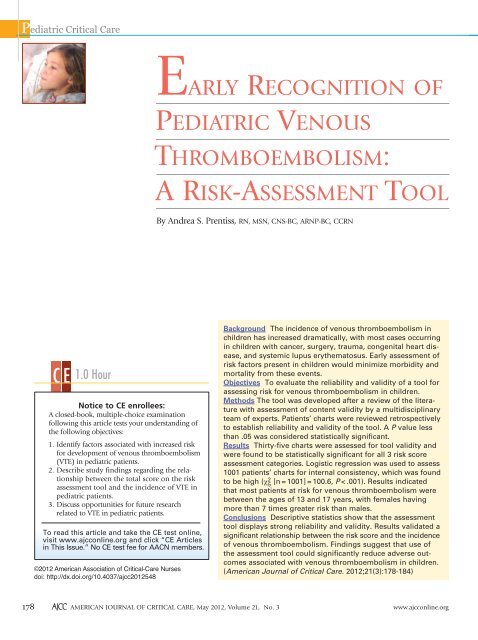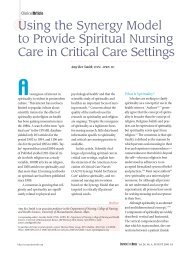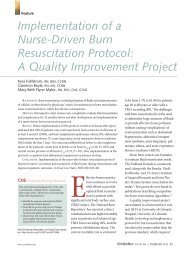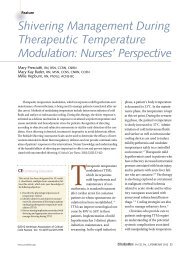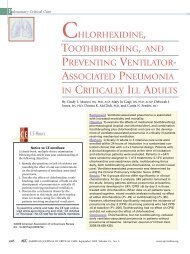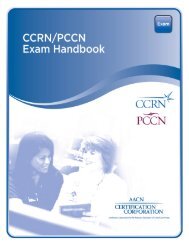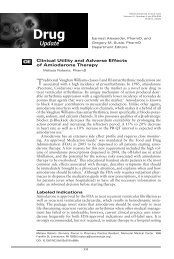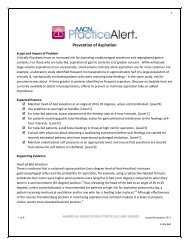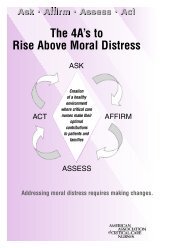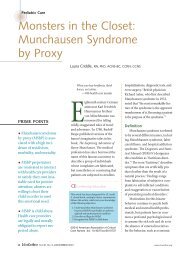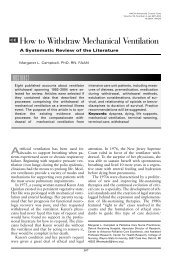Early Recognition of Pediatric Venous Thromboembolism: A Risk ...
Early Recognition of Pediatric Venous Thromboembolism: A Risk ...
Early Recognition of Pediatric Venous Thromboembolism: A Risk ...
Create successful ePaper yourself
Turn your PDF publications into a flip-book with our unique Google optimized e-Paper software.
<strong>Pediatric</strong> Critical Care<br />
EARLY RECOGNITION OF<br />
PEDIATRIC VENOUS<br />
THROMBOEMBOLISM:<br />
A RISK-ASSESSMENT TOOL<br />
By Andrea S. Prentiss, RN, MSN, CNS-BC, ARNP-BC, CCRN<br />
C E<br />
1.0 Hour<br />
Notice to CE enrollees:<br />
A closed-book, multiple-choice examination<br />
following this article tests your under standing <strong>of</strong><br />
the following objectives:<br />
1. Identify factors associated with increased risk<br />
for development <strong>of</strong> venous thromboembolism<br />
(VTE) in pediatric patients.<br />
2. Describe study findings regarding the relationship<br />
between the total score on the risk<br />
assessment tool and the incidence <strong>of</strong> VTE in<br />
pediatric patients.<br />
3. Discuss opportunities for future research<br />
related to VTE in pediatric patients.<br />
To read this article and take the CE test online,<br />
visit www.ajcconline.org and click “CE Articles<br />
in This Issue.” No CE test fee for AACN members.<br />
©2012 American Association <strong>of</strong> Critical-Care Nurses<br />
doi: http://dx.doi.org/10.4037/ajcc2012548<br />
Background The incidence <strong>of</strong> venous thromboembolism in<br />
children has increased dramatically, with most cases occurring<br />
in children with cancer, surgery, trauma, congenital heart disease,<br />
and systemic lupus erythematosus. <strong>Early</strong> assessment <strong>of</strong><br />
risk factors present in children would minimize morbidity and<br />
mortality from these events.<br />
Objectives To evaluate the reliability and validity <strong>of</strong> a tool for<br />
assessing risk for venous thromboembolism in children.<br />
Methods The tool was developed after a review <strong>of</strong> the literature<br />
with assessment <strong>of</strong> content validity by a multidisciplinary<br />
team <strong>of</strong> experts. Patients’ charts were reviewed retrospectively<br />
to establish reliability and validity <strong>of</strong> the tool. A P value less<br />
than .05 was considered statistically significant.<br />
Results Thirty-five charts were assessed for tool validity and<br />
were found to be statistically significant for all 3 risk score<br />
assessment categories. Logistic regression was used to assess<br />
1001 patients’ charts for internal consistency, which was found<br />
to be high (χ 2 5<br />
[n = 1001] = 100.6, P < .001). Results indicated<br />
that most patients at risk for venous thromboembolism were<br />
between the ages <strong>of</strong> 13 and 17 years, with females having<br />
more than 7 times greater risk than males.<br />
Conclusions Descriptive statistics show that the assessment<br />
tool displays strong reliability and validity. Results validated a<br />
significant relationship between the risk score and the incidence<br />
<strong>of</strong> venous thromboembolism. Findings suggest that use <strong>of</strong><br />
the assessment tool could significantly reduce adverse outcomes<br />
associated with venous thromboembolism in children.<br />
(American Journal <strong>of</strong> Critical Care. 2012;21(3):178-184)<br />
178 AJCC AMERICAN JOURNAL OF CRITICAL CARE, May 2012, Volume 21, No. 3 www.ajcconline.org
Thromboembolic events have historically been considered an adult phenomenon.<br />
However, the reporting <strong>of</strong> events in children and neonates has been increasing<br />
because <strong>of</strong> improved diagnosis and care <strong>of</strong> children with congenital heart disease,<br />
cancer, and prematurity. Thromboembolic events may go unreported and undiagnosed,<br />
as children <strong>of</strong>ten cannot report symptoms.<br />
According to the Institute for Healthcare Improvement,<br />
1 venous thromboembolism (VTE) includes<br />
pulmonary embolism, asymptomatic calf vein thrombosis,<br />
and symptomatic deep vein thrombosis (DVT).<br />
For adult patients seen in the hospital, assessment<br />
and early prophylaxis for VTE has become a routine<br />
<strong>of</strong> care. Recognizing the mortality and morbidity<br />
associated with VTE, multiple national groups have<br />
identified regulations for assessing, preventing, and<br />
reporting these events. 2-4<br />
The National Quality Forum endorsed the use<br />
<strong>of</strong> a multidisciplinary approach for risk assessment<br />
and prophylaxis guidelines during hospitalizations<br />
and for establishing evidence-based guidelines for<br />
inpatient and postdischarge prophylaxis. 5 As <strong>of</strong> July<br />
31, 2008, the Centers for Medicaid and Medicare<br />
Services implemented requirements in the adult<br />
population stating that hospital reimbursement will<br />
be for services not related to complications when a<br />
DVT or pulmonary embolism develops after hip or<br />
total knee replacement. 1 They have implemented a<br />
pay for performance initiative empowering physicians<br />
and nurse practitioners to voluntarily report VTE<br />
occurrences and enabling them to receive bonus payments<br />
from Medicare. Hospitals already have mandatory<br />
requirements for reporting patients’ admission<br />
assessments for VTE and the numbers <strong>of</strong> patients<br />
receiving prophylaxis on the basis <strong>of</strong> this assessment.<br />
Those hospitals not meeting this requirement could<br />
lose 2% <strong>of</strong> Medicare reimbursement for the year. 2<br />
<strong>Venous</strong> thromboembolism is an extremely serious<br />
and potentially fatal condition and is considered<br />
very preventable. The literature concerning<br />
assessment, complications, and prevention in adults<br />
is abundant, but little is known about pediatric and<br />
neonatal patients.<br />
An extensive literature review was conducted<br />
by using electronic and manual searches <strong>of</strong> research<br />
About the Author<br />
Andrea S. Prentiss is a clinical nurse specialist at Baptist<br />
Children’s Hospital in Miami, Florida.<br />
Corresponding author: Andrea S. Prentiss, RN, MSN, CNS-BC,<br />
ARNP-BC, CCRN, Baptist Children’s Hospital, 8900 N Kendall<br />
Dr, Miami, FL 33176 (e-mail: andreap@baptisthealth.net).<br />
literature. Once identified, reference lists for the<br />
studies included in the review were considered, and<br />
additional studies found and used by other authors<br />
in this area were obtained and reviewed. Literature<br />
searches were conducted in MEDLINE and CINAHL<br />
for all indexed years by using the following key words:<br />
risk assessment tool, pulmonary embolism, pediatric and<br />
neonates, and deep venous thrombosis. Search fields<br />
were narrowed to age ranges from birth to 21 years<br />
<strong>of</strong> age. A neonatal/pediatric specific risk assessment<br />
tool was not found in the literature review. Scarvelis<br />
and Wells (as cited by Ramzi and Leeper 6 ) adopted<br />
a set <strong>of</strong> rules for clinical prediction <strong>of</strong> DVT that was<br />
based on a previously established set <strong>of</strong> clinical criteria<br />
for pulmonary embolism in adults that had<br />
been modified for use in the neonatal/pediatric<br />
population. However, to date there is not a pure<br />
neonatal/pediatric risk assessment<br />
scoring system available in the literature.<br />
The literature review confirmed<br />
the lack <strong>of</strong> research published on<br />
the assessment and risk associated<br />
with VTE in neonates and children.<br />
A pediatric study 7 in 2004 summarized<br />
findings from approximately<br />
5000 calls received in the 1-800-<br />
NO-CLOTS consultation services.<br />
Data compiled from 1776 children<br />
with systemic thromboembolism<br />
diagnosed between September 1996<br />
and August 2001 indicated that 74%<br />
<strong>of</strong> the children (n = 1312) had venous<br />
thrombus and 18% (n = 230) <strong>of</strong><br />
these were neonates. Infants less than 1 year old<br />
(47%, n = 841) denoted the largest distinct pediatric<br />
age group, and this included 26% neonates (n = 464).<br />
The neonatal period (defined as less than 1 month<br />
<strong>of</strong> age) accounted for 57% (n = 221) <strong>of</strong> the thromboembolic<br />
events while the remaining 43% (n = 170)<br />
had a clot develop after the first month <strong>of</strong> life.<br />
Other pediatric research 8-11 described annual incidence<br />
rates <strong>of</strong> 0.07 to 0.14 per 10 000 children with<br />
rates between 4.9 and 8 per 10 000 admissions to a<br />
pediatric hospital and 24 per 10 000 admissions to a<br />
neonatal intensive care unit. More recent estimates<br />
Hospitals are<br />
required to<br />
report patients’<br />
admission venous<br />
thromboembolism<br />
assessments and<br />
the number <strong>of</strong><br />
patients receiving<br />
prophylaxis.<br />
www.ajcconline.org AJCC AMERICAN JOURNAL OF CRITICAL CARE, May 2012, Volume 21, No. 3 179
Recently, annual<br />
rates <strong>of</strong> venous<br />
thromboembolism<br />
<strong>of</strong> pediatric<br />
hospital<br />
admissions have<br />
increased by 70%.<br />
Costs associated<br />
with venous<br />
thromboembolism<br />
are disproportionately<br />
higher in<br />
children due<br />
to long-term<br />
complications.<br />
from a retrospective study 12 from 2001 to 2007<br />
indicate that the annual rates have increased by<br />
70% to 58 cases per 10 000 hospital admissions<br />
seen in all pediatric age groups. Although pediatric<br />
rates pale in comparison to the annual 200 000 to<br />
600 000 estimated adult rates published in the white<br />
paper from the American Public<br />
Health Association, 13 the morbidity<br />
and mortality associated with them<br />
are as significant.<br />
<strong>Risk</strong> Factors for <strong>Pediatric</strong><br />
Deep Vein Thrombosis<br />
Research indicates central venous<br />
catheters as the most frequent cause<br />
<strong>of</strong> pediatric DVT, with rates being as<br />
high as 90% in the neonatal population<br />
and greater than 50% in all other<br />
age groups. 7,10,14,15 Short-term use <strong>of</strong> a<br />
central venous catheter in children is described as<br />
having higher risks than long-term use <strong>of</strong> central<br />
catheters. 16 Other risk factors identified for pediatric<br />
DVTs include previous DVT history, sepsis or acute<br />
infection, oncologic malignant growths, preexisting<br />
coagulation disorders, surgery/trauma, congenital<br />
heart disease, systemic lupus, obesity, and immobility.<br />
17 Children with musculoskeletal sepsis,<br />
osteomyelitis, or staphylococcal infections may be<br />
at increased risk <strong>of</strong> VTE developing, with staphylococcal<br />
virulence playing a potentially large role in<br />
DVT formation. 15 The literature also demonstrates<br />
that most children (90%) had at least 1 associated<br />
condition and approximately 51% had 2 or more<br />
associated conditions. Perinatal asphyxia, infection,<br />
congenital heart disease, and hypovolemia<br />
have been identified as risk<br />
factors in the neonatal population. 7,10,14<br />
Mortality and Morbidity<br />
Earlier research indicates that the<br />
mortality rate related to pediatric VTE<br />
is 1% to 2%, compared with all-cause<br />
related mortality at 14% to 23% and<br />
cumulative incidence <strong>of</strong> a first VTE<br />
recurrence <strong>of</strong> approximately 9% after<br />
3 years <strong>of</strong> follow-up, with rates reaching<br />
as high as 21% in other studies. 12<br />
More recent studies describe the<br />
mortality rate for patients with a VTE<br />
diagnosis as 8%, compared with 1% for other hospital<br />
diagnoses during the same period. The mean<br />
length <strong>of</strong> stay for patients with a diagnosis <strong>of</strong> VTE<br />
was 28 days compared with 6 days for patients<br />
admitted to the hospital for other reasons. 14<br />
VTE is an increasing problem in infancy, childhood,<br />
and adolescence. Health and related costs<br />
associated with VTE are disproportionately higher<br />
in children as a result <strong>of</strong> its long-term complications.<br />
With accurate assessment and rapid treatment,<br />
children have an excellent chance for recovery from<br />
severe VTE events. Although postthrombotic syndrome<br />
could significantly limit aerobic activities<br />
necessary for normal childhood development, children<br />
could potentially live 60 to 80 years after a<br />
VTE event. 14,17<br />
Methods<br />
Design, Sample, and Procedure<br />
Following an extensive literature review, a tool<br />
for assessing risk for VTE in children was developed.<br />
To establish content validity, the tool was reviewed<br />
by a multidisciplinary team <strong>of</strong> experts that included<br />
pediatric nurses, pediatricians, and pediatric intensivists,<br />
surgeons, radiologists, and pulmonologists.<br />
After data were extrapolated from adult thromboembolism<br />
assessments and review <strong>of</strong> existing<br />
pediatric literature, the pediatric risks were categorized<br />
with points assigned for severity. <strong>Risk</strong> factors<br />
assigned 1 point each were in category 1, factors<br />
assigned 2 points each were in category 2, and factors<br />
assigned 3 points each were in category 3. Scores<br />
within each risk factor category are added, and the<br />
3 category scores are compiled to provide a total<br />
risk score. <strong>Risk</strong> assignment is then based on the<br />
total risk score, with 1 point being potential risk, 2<br />
points medium risk, and 3 or more points indicating<br />
high risk for VTE development. Patients were to<br />
be assessed for the presence <strong>of</strong> VTE at the point <strong>of</strong><br />
admission through history and physical examination<br />
performed by physicians or nurses practitioners.<br />
The assessment tool was then approved by<br />
the Department <strong>of</strong> <strong>Pediatric</strong>s for implementation.<br />
The hospital’s institutional review board approved<br />
the study to determine the reliability and validity<br />
<strong>of</strong> the risk assessment tool. Pilot testing was conducted<br />
with 20 nurses within different pediatric<br />
inpatient areas with different nursing shifts to pretest<br />
the tool. Interdisciplinary education was performed<br />
to ensure proper use <strong>of</strong> the form, and the<br />
form was implemented in November 2008, with<br />
each admitted patient having an assessment <strong>of</strong><br />
documentation <strong>of</strong> risk.<br />
Using the Central Limit Theorem, random sampling<br />
<strong>of</strong> 35 forms was used to determine the validity<br />
<strong>of</strong> the VTE risk assessment tool, correlating the<br />
identified risk assessment score with the medical<br />
record. Random, retrospective chart review was done<br />
by compiling a list <strong>of</strong> pediatric inpatient admissions.<br />
180 AJCC AMERICAN JOURNAL OF CRITICAL CARE, May 2012, Volume 21, No. 3 www.ajcconline.org
The chart <strong>of</strong> every fifth patient was reviewed for<br />
those patients with preprinted admission order sets<br />
with the VTE risk assessment in place or containing<br />
specific orders written to clarify the risk score. In<br />
the event that the fifth identified record did not<br />
meet eligibility requirements, the review went to<br />
the next identified patient.<br />
Reliability was assessed on the basis <strong>of</strong> random,<br />
retrospective chart reviews on 1001 children admitted<br />
to the pediatric inpatient area with the preprinted<br />
admission order sets with the VTE risk assessment<br />
in place or containing specific orders written clarifying<br />
the risk score between November 2008 and<br />
November 2009. Data were collected retrospectively<br />
to compare the patient’s medical record and the<br />
assessment tool to determine the risk for development<br />
<strong>of</strong> VTE. Demographic information included<br />
age, sex, and risk factor information on the risk<br />
assessment tool. Patients were also assessed for the<br />
presence <strong>of</strong> VTE.<br />
Statistical Analysis<br />
Data were analyzed by using the Statistical Package<br />
<strong>of</strong> the Social Sciences Program (SPSS) for Windows<br />
13 (IBM SPSS, Armonk, New York). The research<br />
questions were answered by the Cramér V association<br />
test and a logistic regression model. A P value<br />
less than .05 was considered statistically significant.<br />
In order to validate the risk assessment tool,<br />
the documented risk score was compared with the<br />
medical record notes, with risk scores categorized<br />
as follows: risk score 1, 0-6; risk score 2, 0-4; and<br />
risk score 3, 0-2 based on the assessment tool. The<br />
statistical test used to test the hypothesis was<br />
Cramér’s V association test to determine the relationship<br />
between the 2 variables with ranges from -1 to<br />
1. Results showed statistical significance in all 3<br />
risk score categories (0.92, P ≤ .001; 0.74, P ≤ .001;<br />
1.00, P ≤ .001).<br />
A χ 2 test (with Yates continuity correction) and<br />
direct logistic regression were performed to assess<br />
the tool’s reliability, assessing the correlation between<br />
risk scores and the likelihood <strong>of</strong> a VTE developing.<br />
Variables included specific risk scores <strong>of</strong> 1, 2, and<br />
3, sex, and age.<br />
Results<br />
Demographic Data<br />
A total <strong>of</strong> 1001 patients were assessed on admission<br />
for risk <strong>of</strong> VTE. Demographic characteristics are<br />
summarized in Table 1. More than 50% <strong>of</strong> the patients<br />
assessed were less than 5 years old. The mean age <strong>of</strong><br />
the patients assessed was 6.91 years: 7.29 years for<br />
female patients and 6.64 years for male patients.<br />
Table 1<br />
Demographics <strong>of</strong> patients assessed<br />
Characteristic<br />
Sex, No. (%) <strong>of</strong> patients<br />
Male<br />
Female<br />
Age, mean (SD), y<br />
Male<br />
Female<br />
Age range, No. (%) <strong>of</strong> patients<br />
0-5 y<br />
6-11 y<br />
12-20 y<br />
Table 2<br />
Association between venous<br />
thromboembolism and patient’s sex<br />
Sex<br />
Female<br />
Male<br />
Total<br />
<strong>Venous</strong> thromboembolism<br />
Absent<br />
406 (96.7)<br />
575 (99.0)<br />
981<br />
Present<br />
14 (3.3)<br />
6 (1.0)<br />
20<br />
Association <strong>of</strong> VTE With Age and Sex<br />
Of the 1001 patients assessed, 981 patients<br />
(98% <strong>of</strong> patients surveyed) did not have a diagnosis<br />
<strong>of</strong> VTE (indicated by 0) and 20 patients (2%)<br />
had VTE (indicated by 1). Phi and Cramér’s V were<br />
calculated in order to evaluate the effect size, with<br />
both results being identical. Based<br />
on these results, it can be concluded<br />
that the effect size is irrelevant<br />
(Cramér’s V = ø = √6.59/1001 =<br />
0.081).<br />
Of the 20 patients (2%) with<br />
venous thromboembolism, 14 or<br />
70% were female, indicating a relationship<br />
between female sex and<br />
VBE (Table 2). Results were statistically<br />
significant (χ 2 1<br />
[n = 1001] = 6.6,<br />
P = .01). As this was a 2 × 2 table,<br />
Yates correction for continuity was used, which was<br />
statistically significant (P = .02). Table 3 shows that<br />
most <strong>of</strong> the patients at risk for VTE were between<br />
the ages <strong>of</strong> 13 and 17 years.<br />
Correlation <strong>of</strong> VTE and <strong>Risk</strong> Score<br />
The trend <strong>of</strong> the risk scores in Table 4 suggests<br />
a significant association between the risk score and<br />
the incidence <strong>of</strong> VTE (χ 2 6<br />
[n = 1001] = 340.7, P ≤ .001).<br />
Because only 20 patients had VTE diagnosed, multiple<br />
cells in Table 4 have fewer than the expected count.<br />
Value<br />
581 (58)<br />
420 (42)<br />
6.91 (6.26)<br />
6.63 (6.14)<br />
7.29 (6.40)<br />
525 (52.5)<br />
171 (17.1)<br />
305 (30.5)<br />
Total<br />
420<br />
581<br />
1001<br />
Most <strong>of</strong> the<br />
patients at risk for<br />
venous thromboembolism<br />
were<br />
between the ages<br />
<strong>of</strong> 13 and 17 years.<br />
www.ajcconline.org AJCC AMERICAN JOURNAL OF CRITICAL CARE, May 2012, Volume 21, No. 3 181
Table 3<br />
Association between venous<br />
thromboembolism and age<br />
<strong>Venous</strong> thromboembolism a<br />
Absent Present Total<br />
0<br />
1<br />
2<br />
3<br />
4<br />
5<br />
6<br />
7<br />
8<br />
9<br />
10<br />
11<br />
12<br />
13<br />
14<br />
15<br />
16<br />
17<br />
18<br />
19<br />
20<br />
Total<br />
189 (100.0)<br />
102 (99.0)<br />
77 (100.0)<br />
70 (100.0)<br />
46 (100.0)<br />
39 (97.5)<br />
36 (100.0)<br />
36 (100.0)<br />
27 (100.0)<br />
22 (100.0)<br />
28 (100.0)<br />
22 (100.0)<br />
26 (100.0)<br />
26 (96.3)<br />
41 (91.1)<br />
50 (92.6)<br />
62 (98.4)<br />
66 (89.2)<br />
11 (100.0)<br />
4 (100.0)<br />
1 (100.0)<br />
981 (98.0)<br />
a Values are number (percentage) <strong>of</strong> patients.<br />
Table 4<br />
Cross-tabulation <strong>of</strong> risk score vs<br />
venous thromboembolism<br />
<strong>Risk</strong> score<br />
0<br />
1<br />
2<br />
3<br />
4<br />
5<br />
6<br />
Total<br />
0 (0.0)<br />
1 (1.0)<br />
0 (0.0)<br />
0 (0.0)<br />
0 (0.0)<br />
1 (2.5)<br />
0 (0.0)<br />
0 (0.0)<br />
0 (0.0)<br />
0 (0.0)<br />
0 (0.0)<br />
0 (0.0)<br />
0 (0.0)<br />
1 (3.7)<br />
4 (8.9)<br />
4 (7.4)<br />
1 (1.6)<br />
8 (10.8)<br />
0 (0.0)<br />
0 (0.0)<br />
0 (0.0)<br />
20 (2.0)<br />
<strong>Venous</strong> thromboembolism a<br />
Absent<br />
862 (99.9)<br />
25 (92.6)<br />
72 (93.5)<br />
10 (83.3)<br />
9 (81.8)<br />
3 (30.0)<br />
0 (0.0)<br />
981 (98.0)<br />
a Values are number (percentage) <strong>of</strong> patients.<br />
Present<br />
1 (0.1)<br />
2 (7.4)<br />
5 (6.5)<br />
2 (16.7)<br />
2 (18.2)<br />
7 (70.0)<br />
1 (100.0)<br />
20 (2.0)<br />
189<br />
103<br />
77<br />
70<br />
46<br />
40<br />
36<br />
36<br />
27<br />
22<br />
28<br />
22<br />
26<br />
27<br />
45<br />
54<br />
63<br />
74<br />
11<br />
4<br />
1<br />
1001<br />
Total<br />
863<br />
27<br />
77<br />
12<br />
11<br />
10<br />
1<br />
1001<br />
Use <strong>of</strong> Direct Logistic Regression to Predict<br />
VTE in Children<br />
Direct logistic regression was used to predict<br />
the probability <strong>of</strong> the occurrence <strong>of</strong> VTE on the<br />
basis <strong>of</strong> specific identified risk factors, which were<br />
categorized according to level <strong>of</strong> risk. Other variables<br />
included the patient’s age and sex. Results indicate<br />
that female sex is a strong predictor <strong>of</strong> VTE occurrence,<br />
with an odds ratio <strong>of</strong> 7.047. Table 5 suggests<br />
that patients with risk scores <strong>of</strong> 3 were 4.8 times<br />
more likely to have VTE develop. There was an adequate<br />
sample size (n = 1001) <strong>of</strong> reviewed charts;<br />
however, only 20 (2%) were positive for VTE, which<br />
may explain the close association in predictability<br />
in risk scores, suggesting that more charts <strong>of</strong> patients<br />
with a diagnosis <strong>of</strong> VTE should be explored.<br />
The model was statistically significant (χ 2 5 [n =<br />
1001] = 100.6, P < .001), indicating the ability to distinguish<br />
those patients who would be positive for<br />
VTE according to the assessment tool.<br />
Future Research<br />
Approval has been obtained from the institutional<br />
review board for a logistic regression analysis<br />
in order to assess the tool concurrently with<br />
patients admitted.<br />
Multiple opportunities exist for future pediatric<br />
VTE research. Anecdotal evidence accrued while<br />
collecting data suggests that children with inflammatory<br />
bowel disease and deficiency <strong>of</strong> factors C<br />
and S may have a higher incidence <strong>of</strong> thrombotic<br />
events. In order to assess these patients accurately,<br />
interdisciplinary education will be performed.<br />
Revisions <strong>of</strong> the tool will be discussed with the<br />
team to possibly amend the level 3 risk factor category<br />
to ensure that these patients are identified as<br />
being at risk.<br />
<strong>Pediatric</strong> inpatients experiencing extended stays<br />
pose another opportunity, as these patients may<br />
warrant reassessment <strong>of</strong> risk on the basis <strong>of</strong> changes<br />
in their condition. Another area worthy <strong>of</strong> research<br />
as identified in the literature review is the assessment<br />
<strong>of</strong> VTE risk in neonates. Because few cases <strong>of</strong><br />
pediatric VTE have been reported, further studies<br />
must be conducted in this area with a much larger<br />
sample size in order to assess the reliability and<br />
validity <strong>of</strong> the tool better.<br />
Conclusions<br />
In summary, we verified the reliability and<br />
validity <strong>of</strong> the tool for assessing risk for VTE in children.<br />
Most patients at risk for VTE were between 13<br />
and 17 years <strong>of</strong> age, with females having more than<br />
7 times more risk than males. Data suggest that the<br />
182 AJCC AMERICAN JOURNAL OF CRITICAL CARE, May 2012, Volume 21, No. 3 www.ajcconline.org
higher the identified risk score, the greater the risk<br />
<strong>of</strong> VTE, demonstrating a significant relationship<br />
between the risk score and incidence <strong>of</strong> VTE.<br />
These preliminary results demonstrate that broad<br />
use <strong>of</strong> this risk assessment tool is beneficial for<br />
patients with a history and clinical criteria suggestive<br />
<strong>of</strong> the probability <strong>of</strong> VTE developing. Implementation<br />
<strong>of</strong> the risk assessment tool could reduce<br />
the morbidity and mortality associated with thrombotic<br />
events.<br />
ACKNOWLEDGMENT<br />
Mario Cardona, statistician at Baptist Hospital, is acknowledged<br />
for his assistance with the statistical analysis.<br />
FINANCIAL DISCLOSURES<br />
None reported.<br />
Table 5<br />
Logistic regression predicting venous<br />
thromboembolism by using the pediatric risk<br />
assessment tool in 1001 inpatient chart reviews<br />
Predictor<br />
from step 1<br />
<strong>Risk</strong> score 1<br />
<strong>Risk</strong> score 2<br />
<strong>Risk</strong> score 3<br />
Female<br />
Age<br />
Constant<br />
Variables in the equation a<br />
B<br />
1.487<br />
1.034<br />
1.575<br />
1.953<br />
0.100<br />
-7.938<br />
SE<br />
0.435<br />
0.218<br />
0.292<br />
0.738<br />
0.065<br />
1.081<br />
Wald<br />
11.656<br />
22.589<br />
29.014<br />
6.998<br />
2.402<br />
53.958<br />
a Statistics for the overall model: χ 2 = 100.557, df =5, P < .001.<br />
b All comparisons had 1 degree <strong>of</strong> freedom.<br />
P b<br />
.001<br />
CE Test Test ID A1221032: <strong>Early</strong> <strong>Recognition</strong> <strong>of</strong> <strong>Pediatric</strong> <strong>Venous</strong> <strong>Thromboembolism</strong> Via a <strong>Risk</strong>-Assessment Tool.<br />
Learning objectives: 1. Identify factors associated with increased risk for development <strong>of</strong> venous thromboembolism (VTE) in pediatric patients. 2. Describe<br />
study findings regarding the relationship between the total score on the risk assessment tool and the incidence <strong>of</strong> VTE in pediatric patients. 3. Discuss opportunities<br />
for future research related to VTE in pediatric patients.<br />
1. Which <strong>of</strong> the following is associated with the highest risk for pediatric<br />
deep vein thrombosis (DVT)?<br />
a. Patient age <strong>of</strong> less than 1 month and long-term central venous catheter use<br />
b. Patient age <strong>of</strong> less than 1 month and short-term central venous catheter use<br />
c. Patient age <strong>of</strong> 1 to 12 months and long-term central venous catheter use<br />
d. Patient age <strong>of</strong> 1 to 12 months and short-term central venous catheter use<br />
2. Which <strong>of</strong> the following does the author cite as a reason for thromboembolic<br />
events being undiagnosed in pediatric patients?<br />
a. <strong>Venous</strong> thromboembolism (VTE) in patients younger than 18 years <strong>of</strong> age is too rare<br />
to justify routine assessment <strong>of</strong> every patient.<br />
b. Current regulations require assessment for VTE in adult patients only.<br />
c. Clinical criteria for diagnosis <strong>of</strong> VTE in patients younger than 18 years <strong>of</strong> age are<br />
significantly lacking.<br />
d. Children are frequently unable to report their symptoms.<br />
3. Which <strong>of</strong> the following statements regarding the incidence <strong>of</strong> VTE in pediatric<br />
and adult patient populations is true?<br />
a. Incident rates in pediatric patients are similar to incident rates in adults, but the<br />
morbidity and mortality associated with them are significantly higher in the adult<br />
patients.<br />
b. Incident rates in pediatric patients are similar to incident rates in adults, but the<br />
morbidity and mortality associated with them are significantly higher in the<br />
pediatric patients.<br />
c. Incident rates in pediatric patients are lower than incident rates in adults, but the<br />
morbidity and mortality associated with them are similar for both groups.<br />
d. Incident rates in pediatric patients are lower than incident rates in adults, but the<br />
morbidity and mortality associated with them are significantly higher in the<br />
pediatric patients.<br />
4. The health-related costs associated with VTE in children are disproportionately<br />
higher due to the expenses specif ically related to which <strong>of</strong> the following?<br />
a. Lengthy hospitalizations<br />
b. Long-term complications<br />
c. Treatment <strong>of</strong> comorbidities, such as disseminated intravascular coagulation (DIC)<br />
d. Ongoing DVT prophylaxis<br />
5. Which <strong>of</strong> the following was the mean length <strong>of</strong> stay for pediatric patients<br />
with a diagnosis <strong>of</strong> VTE compared to that <strong>of</strong> pediatric patients admitted to<br />
the hospital for other reasons?<br />
a. Between 2 and 3 times higher for VTE than for other reasons<br />
b. Between 3 and 4 times higher for VTE than for other reasons<br />
c. Between 4 and 5 times higher for VTE than for other reasons<br />
d. Between 5 and 6 times higher for VTE than for other reasons<br />
6. According to the risk assessment tool for VTE in children, which <strong>of</strong> the following<br />
would be assigned a score <strong>of</strong> 3 points each?<br />
a. Sepsis and acute DIC<br />
b. Obesity and immobility<br />
c. Acquired abnormalities <strong>of</strong> anticoagulant factors and hereditary anticoagulation<br />
abnormalities<br />
d. Oral contraceptive use and family history <strong>of</strong> coagulopathy<br />
7. Which <strong>of</strong> the following levels <strong>of</strong> risk would be assigned to a total score <strong>of</strong><br />
3 points on the risk assessment tool?<br />
a. Potential risk c. Medium risk<br />
b. Low risk d. High risk<br />
8. Which <strong>of</strong> the following is thought to play a potentially large role in DVT formation<br />
in children?<br />
a. Congenital heart disease<br />
b. Systemic lupus<br />
c. Virulent staphylococcal infection<br />
d. Oncologic malignant growth(s)<br />
9. Pretesting <strong>of</strong> the VTE risk assessment tool involved which <strong>of</strong> the following?<br />
a. Multiple nursing shifts and different pediatric inpatient units<br />
b. Multiple nursing shifts and 1 pediatric inpatient unit<br />
c. One specific nursing shift and different pediatric inpatient units<br />
d. One specific nursing shift and 1 pediatric inpatient unit<br />
10. Of the 1001 patients who were assessed on admission for risk <strong>of</strong> VTE in the<br />
study, more than half <strong>of</strong> them were <strong>of</strong> which <strong>of</strong> the following ages?<br />
a. Younger than 3 years old<br />
b. Younger than 4 years old<br />
c. Younger than 5 years old<br />
d. Younger than 6 years old<br />
11. Anecdotal evidence collected during this study suggests that children with<br />
which <strong>of</strong> the following conditions may have a higher incidence <strong>of</strong> thrombotic<br />
events?<br />
a. Deficiency <strong>of</strong> factors IV and XIII<br />
b. Deficiency <strong>of</strong> factors VII and VIII<br />
c. Gastric esophageal reflux disease<br />
d. Inflammatory bowel disease<br />
12. At which <strong>of</strong> the following ages did VTE occur most <strong>of</strong>ten?<br />
a. 17 years c. 14 years<br />
b. 15 years d. 13 years<br />
Test ID: A1221032 Contact hours: 1.0 Form expires: May 1, 2014. Test Answers: Mark only one box for your answer to each question. You may photocopy this form.<br />
1. ❑a 2. ❑a 3. ❑a 4. ❑a 5. ❑a 6. ❑a 7. ❑a 8. ❑a 9. ❑a 10. ❑a 11. ❑a 12. ❑a<br />
❑b ❑b ❑b ❑b ❑b ❑b ❑b ❑b ❑b ❑b ❑b ❑b<br />
❑c ❑c ❑c ❑c ❑c ❑c ❑c ❑c ❑c ❑c ❑c ❑c<br />
❑d ❑d ❑d ❑d ❑d ❑d ❑d ❑d ❑d ❑d ❑d ❑d<br />
Fee: AACN members, $0; nonmembers, $10 Passing score: 9 correct (75 %) Category: A, Synergy CERP A Test writer: Ann Lystrup, RN, BSN, CEN, CFRN, CSPI, CCRN<br />
Program evaluation<br />
Yes No<br />
Name<br />
Objective 1 was met ❑ ❑ Address<br />
Objective 2 was met ❑ ❑<br />
Objective 3 was met ❑ ❑ City State ZIP<br />
Content was relevant to my<br />
nursing practice ❑ ❑<br />
Country Phone E-mail address<br />
My expectations were met ❑ ❑<br />
This method <strong>of</strong> CE is effective<br />
AACN Customer ID#<br />
for this content ❑ ❑<br />
The level <strong>of</strong> difficulty <strong>of</strong> this test was:<br />
❑ easy ❑ medium ❑ difficult<br />
Payment by: ❑ Visa ❑ M/C ❑ AMEX ❑ Check<br />
For faster processing, take<br />
this CE test online at<br />
www.ajcconline.org (“CE<br />
Articles in This Issue”) or<br />
mail this entire page to:<br />
AACN, 101 Columbia,<br />
Aliso Viejo, CA 92656.<br />
To complete this program,<br />
it took me hours/minutes.<br />
Card #<br />
Signature<br />
Expiration Date<br />
The American Association <strong>of</strong> Critical-Care Nurses is accredited as a provider <strong>of</strong> continuing nursing education by the American Nurses Credentialing Center’s Commission on Accreditation.<br />
AACN has been approved as a provider <strong>of</strong> continuing education in nursing by the State Boards <strong>of</strong> Nursing <strong>of</strong> Alabama (#ABNP0062), California (#01036), and Louisiana (#ABN12). AACN<br />
programming meets the standards for most other states requiring mandatory continuing education credit for relicensure.


